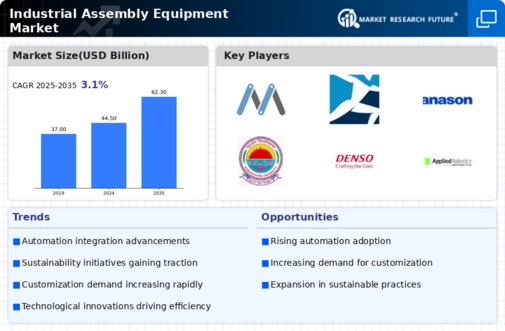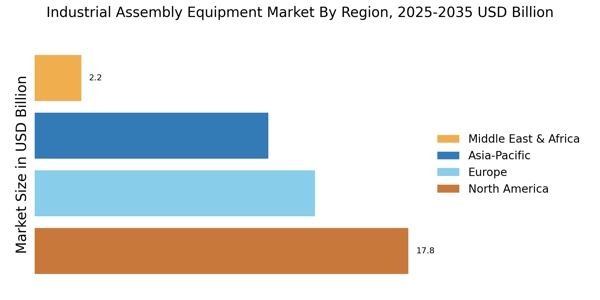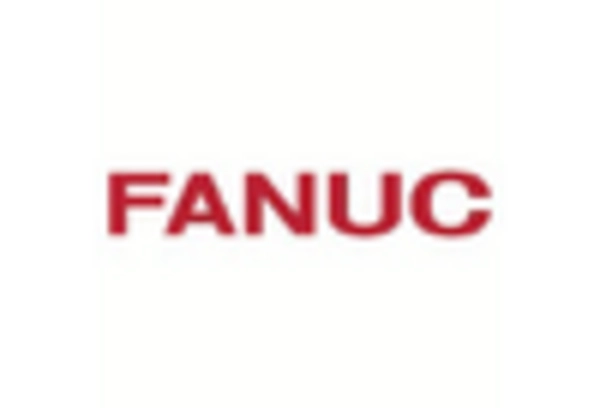Focus on Sustainability
Sustainability has emerged as a critical driver within the Industrial Assembly Equipment Market. As environmental concerns gain prominence, manufacturers are increasingly adopting eco-friendly practices and equipment. The market is witnessing a shift towards energy-efficient assembly solutions that minimize waste and reduce carbon footprints. Recent studies indicate that companies implementing sustainable practices can achieve cost savings of up to 20% in operational expenses. This trend is not merely a response to regulatory pressures but also reflects changing consumer preferences for environmentally responsible products. As a result, manufacturers are investing in sustainable materials and energy-efficient technologies, which are expected to shape the future of the Industrial Assembly Equipment Market. The emphasis on sustainability is likely to foster innovation, leading to the development of new equipment that meets both performance and environmental standards.
Rising Demand for Automation
The Industrial Assembly Equipment Market is experiencing a notable surge in demand for automation solutions. As industries strive for enhanced efficiency and productivity, the integration of automated assembly equipment becomes increasingly vital. According to recent data, the automation segment is projected to grow at a compound annual growth rate of approximately 8% over the next five years. This growth is driven by the need for precision, reduced labor costs, and improved production rates. Companies are investing in advanced robotics and automated systems to streamline their assembly processes, thereby reducing human error and increasing output. The shift towards automation not only enhances operational efficiency but also aligns with the broader trend of digital transformation across various sectors. Consequently, the Industrial Assembly Equipment Market is likely to witness significant advancements in technology and innovation as manufacturers adapt to these evolving demands.
Global Supply Chain Optimization
Supply chain optimization is emerging as a crucial driver within the Industrial Assembly Equipment Market. As companies strive to enhance their operational efficiency, the focus on streamlining supply chains has intensified. Recent analyses suggest that effective supply chain management can reduce production costs by up to 25%. This optimization involves the integration of advanced assembly equipment that facilitates smoother workflows and minimizes bottlenecks. Manufacturers are increasingly investing in technologies that enhance visibility and control over their supply chains, enabling them to respond swiftly to market demands. The emphasis on supply chain efficiency not only improves profitability but also enhances customer satisfaction by ensuring timely delivery of products. As a result, the Industrial Assembly Equipment Market is likely to witness a growing demand for equipment that supports these optimization efforts.
Technological Advancements in Equipment
Technological advancements are playing a pivotal role in shaping the Industrial Assembly Equipment Market. Innovations such as artificial intelligence, machine learning, and the Internet of Things are revolutionizing assembly processes. These technologies enable real-time monitoring and predictive maintenance, significantly enhancing equipment reliability and performance. Recent reports indicate that the adoption of smart assembly equipment could lead to productivity increases of up to 30%. Furthermore, the integration of advanced sensors and data analytics allows manufacturers to optimize their operations, reducing downtime and improving overall efficiency. As industries continue to embrace these technological advancements, the Industrial Assembly Equipment Market is expected to evolve rapidly, with manufacturers seeking to leverage cutting-edge solutions to maintain a competitive edge.
Customization and Flexibility in Production
The need for customization and flexibility is increasingly influencing the Industrial Assembly Equipment Market. As consumer preferences evolve, manufacturers are compelled to adapt their production processes to accommodate diverse product specifications. This trend is particularly evident in sectors such as automotive and electronics, where tailored solutions are paramount. The market is responding by offering modular assembly equipment that can be easily reconfigured to meet varying production requirements. Data suggests that companies embracing flexible manufacturing systems can enhance their responsiveness to market changes, potentially increasing their market share by up to 15%. This adaptability not only improves operational efficiency but also allows manufacturers to cater to niche markets effectively. Consequently, the Industrial Assembly Equipment Market is likely to see a rise in demand for versatile assembly solutions that can seamlessly integrate into existing production lines.


















Leave a Comment